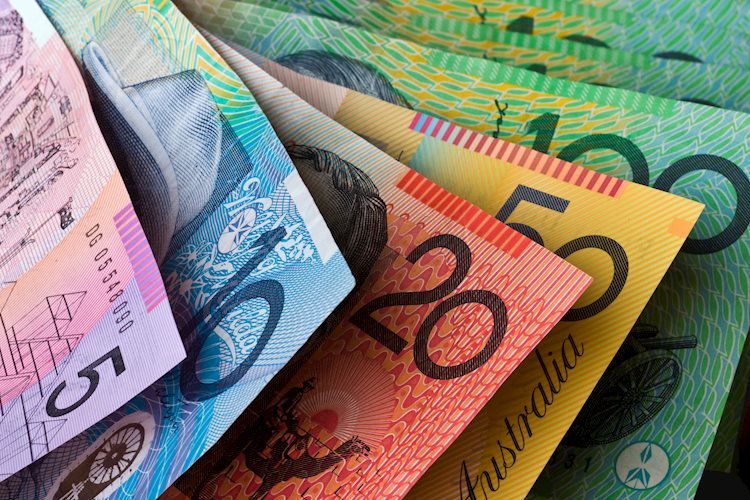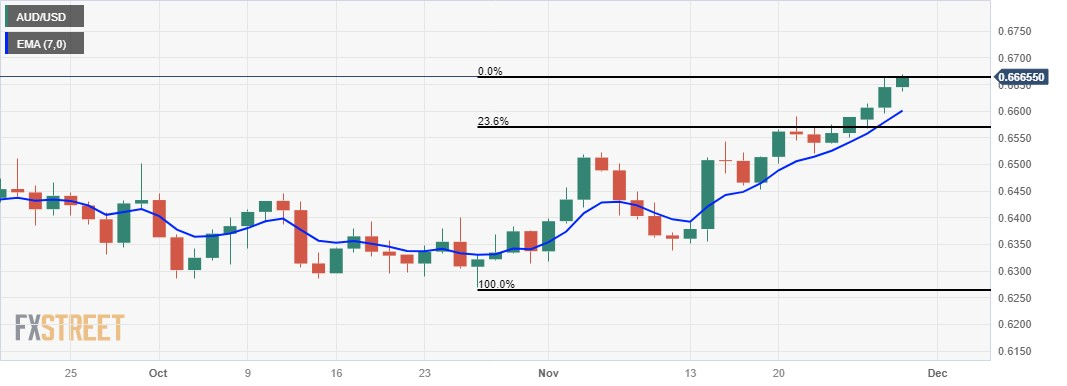- Australian Dollar continues its winning streak despite downbeat Aussie monthly CPI.
- Australia’s Monthly Consumer Price Index declined by 4.9% in October against the expected 5.2%.
- US Dollar Index loses ground despite the better-than-expected US economic data.
The Australian Dollar (AUD) is on a winning streak, extending its gains for the fifth consecutive day on Wednesday. This surge is attributed to a heightened risk appetite in the market and the upward movement in commodity prices. Additionally, the softer US Dollar (USD), influenced by a less hawkish stance from the US Federal Reserve (Fed), is providing support to the AUD/USD pair.
Australia’s Monthly Consumer Price Index (CPI) for October shows a reading of 4.9%, a decrease from the previous reading of 5.6% in September and slightly below the expected 5.2%. While the downbeat data have initially exerted some pressure, it seems that the Australian Dollar (AUD) has managed to recover from that pressure.
The US Dollar Index (DXY) has dipped to its lowest level since August 11 despite the better-than-expected Housing Price Index and Consumer Confidence data from the United States (US). The decline in US Treasury yields acted as an additional negative factor for the Greenback.
Fed Governor Christopher Waller’s comments, suggesting that if inflation consistently declines, there’s no need to insist on maintaining high interest rates, further fueled the negative momentum for the Greenback.
Daily Digest Market Movers: Australian Dollar extends its gains despite downbeat Aussie data, softer US Dollar
- Australia’s seasonally adjusted Retail Sales data showed monthly readings for October, which declined by 0.2% against the market expectations of a 0.1% rise and 0.9% prior.
- Reserve Bank of Australia (RBA) Governor Michele Bullock highlighted that the current monetary policy is on the restrictive side, with rate hikes putting a damper on demand, particularly in the context of persistent services inflation.
- Governor Bullock emphasized the need for caution in employing high interest rates to combat inflation without inadvertently raising the unemployment rate.
- The People’s Bank of China (PBoC) has issued a notice to strengthen financial support for private firms. This comprehensive support encompasses assistance for private enterprises in listing and financing, mergers and acquisitions, as well as restructuring.
- Federal Open Market Committee (FOMC) meeting minutes revealed that members decided unanimously to keep policy restrictive for some time until there is clear and sustainable evidence of inflation moving down toward the Committee’s target.
- US Housing Price Index (MoM) remained consistent at 0.6% in September against the expected figure of 0.4%.
- The CB Consumer Confidence Index experienced an increase in November, rising to 102.0. This uptick comes after a downward revision of October figures, which were adjusted from 102.6 to 99.1.
Technical Analysis: Australian Dollar maintains its position above 0.6650 major level
The Australian Dollar trades higher around the 0.6670 level on Wednesday. The next significant resistance lies at the psychological level of 0.6700. A breakthrough above this level could potentially support the AUD/USD pair, allowing it to test the region around August’s high at 0.6723. On the downside, the key support is positioned at 0.6650, followed by the seven-day Exponential Moving Average (EMA) at 0.6601. A decisive break below the EMA could potentially push the pair to reach the support near the 23.6% Fibonacci retracement level at 0.6569.
AUD/USD: Daily Chart
Australian Dollar price today
The table below shows the percentage change of Australian Dollar (AUD) against listed major currencies today. Australian Dollar was the strongest against the US Dollar.
| USD | EUR | GBP | CAD | AUD | JPY | NZD | CHF | |
| USD | -0.08% | -0.14% | -0.14% | -0.15% | -0.15% | -0.82% | -0.09% | |
| EUR | 0.08% | -0.03% | -0.07% | -0.11% | -0.10% | -0.79% | -0.02% | |
| GBP | 0.11% | 0.03% | -0.01% | -0.08% | -0.07% | -0.77% | 0.03% | |
| CAD | 0.15% | 0.07% | 0.02% | 0.00% | 0.00% | -0.67% | 0.05% | |
| AUD | 0.20% | 0.10% | 0.06% | 0.03% | 0.00% | -0.67% | 0.10% | |
| JPY | 0.15% | 0.08% | 0.04% | 0.04% | 0.01% | -0.65% | 0.09% | |
| NZD | 0.89% | 0.76% | 0.73% | 0.72% | 0.72% | 0.71% | 0.77% | |
| CHF | 0.09% | 0.01% | -0.03% | -0.04% | -0.09% | -0.09% | -0.76% |
The heat map shows percentage changes of major currencies against each other. The base currency is picked from the left column, while the quote currency is picked from the top row. For example, if you pick the Euro from the left column and move along the horizontal line to the Japanese Yen, the percentage change displayed in the box will represent EUR (base)/JPY (quote).
Australian Dollar FAQs
One of the most significant factors for the Australian Dollar (AUD) is the level of interest rates set by the Reserve Bank of Australia (RBA). Because Australia is a resource-rich country another key driver is the price of its biggest export, Iron Ore. The health of the Chinese economy, its largest trading partner, is a factor, as well as inflation in Australia, its growth rate and Trade Balance. Market sentiment – whether investors are taking on more risky assets (risk-on) or seeking safe-havens (risk-off) – is also a factor, with risk-on positive for AUD.
The Reserve Bank of Australia (RBA) influences the Australian Dollar (AUD) by setting the level of interest rates that Australian banks can lend to each other. This influences the level of interest rates in the economy as a whole. The main goal of the RBA is to maintain a stable inflation rate of 2-3% by adjusting interest rates up or down. Relatively high interest rates compared to other major central banks support the AUD, and the opposite for relatively low. The RBA can also use quantitative easing and tightening to influence credit conditions, with the former AUD-negative and the latter AUD-positive.
China is Australia’s largest trading partner so the health of the Chinese economy is a major influence on the value of the Australian Dollar (AUD). When the Chinese economy is doing well it purchases more raw materials, goods and services from Australia, lifting demand for the AUD, and pushing up its value. The opposite is the case when the Chinese economy is not growing as fast as expected. Positive or negative surprises in Chinese growth data, therefore, often have a direct impact on the Australian Dollar and its pairs.
Iron Ore is Australia’s largest export, accounting for $118 billion a year according to data from 2021, with China as its primary destination. The price of Iron Ore, therefore, can be a driver of the Australian Dollar. Generally, if the price of Iron Ore rises, AUD also goes up, as aggregate demand for the currency increases. The opposite is the case if the price of Iron Ore falls. Higher Iron Ore prices also tend to result in a greater likelihood of a positive Trade Balance for Australia, which is also positive of the AUD.
The Trade Balance, which is the difference between what a country earns from its exports versus what it pays for its imports, is another factor that can influence the value of the Australian Dollar. If Australia produces highly sought after exports, then its currency will gain in value purely from the surplus demand created from foreign buyers seeking to purchase its exports versus what it spends to purchase imports. Therefore, a positive net Trade Balance strengthens the AUD, with the opposite effect if the Trade Balance is negative.

